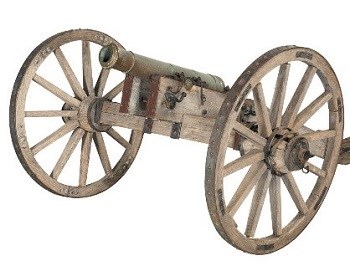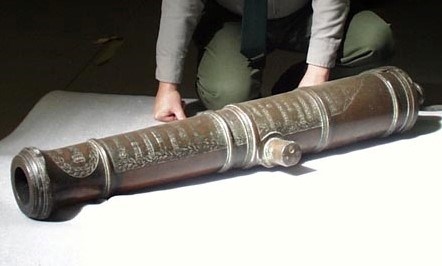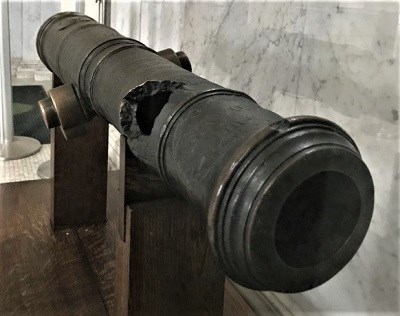Last updated: February 26, 2025
Article
A Tale of Two Cannons

Boston Daily Globe, April 19, 1898
Two bronze cannons named "The Adams" and "The Hancock" once stood in the chamber at the top of the Bunker Hill Monument. They had been there since the monument's opening in 1843, as seen in this Boston Globe newspaper illustration from 1898.
The builders of the Monument hoped that the cannons, like the Monument, would encourage Americans to think about the American Revolutionary War as their shared history.[1] While not used in the Battle of Bunker Hill, the cannons contributed to the Continental army's success in the Revolutionary War.
These cannons were originally part of the artillery arsenal of colonial Boston; they were joined by two other bronze cannons, all likely made in England.[2] It was a time of peace in the colonies following the French and Indian War when Boston acquired these four cannons in 1768, but peace did not last.
In 1775, British soldiers had been stationed in Boston to enforce the Coercive Acts imposed on Massachusetts by the British government in the aftermath of the Boston Tea Party. Responding to this enforcement, Patriots smuggled the four bronze cannons from the town arsenal out of Boston, foiling British guards. They took these cannons to James Barrett's farm in Concord, Massachusetts for safekeeping as antagonisms continued.[3]
The British failed to find the cannons when they entered Concord on April 19, 1775. The four cannons became part of the artillery of the Continental army led by George Washington. Although the Continental army used these cannons against British forces throughout the Revolutionary War, there is no record of which battles they were in. During the war, two of the four cannons were lost.

Courtesy of Rock Island Auction Company
The remaining two cannons were returned to Massachusetts after the war. In 1788, the cannons were named "The Adams" and "The Hancock," after the patriots Samuel Adams and John Hancock. They were kept in a Massachusetts militia armory until 1843 when they were installed in the Bunker Hill Monument.[4]
"The Adams" and "The Hancock" are known as "three pounders" since they could fire cast-iron balls weighing three pounds. When fired, they could reach a target up to 800 yards away.[5] The cannons weigh about 450 pounds each and are about four feet long; a two-wheeled carriage drawn by a horse moved them into battle. Each cannon needed four to five men to fire it. Effective and fearsome weapons, these cannons helped the American colonists win their war of independence.[6]
In 1969, officials removed "The Hancock" cannon from the monument when a bracket holding it to the wall broke. The Commonwealth of Massachusetts, then caretaker of the monument, lost track of "The Hancock" cannon.

NPS Photo
Twenty years later, in 1989, "The Hancock" surfaced in a state police storage-room not far from the monument. The National Park Service, caretaker of the monument after 1975, put "The Hancock" cannon in archival storage at the Boston National Historical Park in the Charlestown Navy Yard.[7]
In 2005, the James Barrett Farm, once the hiding place for these cannons, was set to undergo a restoration. Inspired by this development, local historian J.L. Bell suggested to the National Park Service that “The Hancock” should go on display at the North Bridge Visitor Center, part of the Minute Man National Historical Park, not far from the Barrett Farm.[8] The Bunker Hill Monument Association, which still owns the cannons, agreed. "The Hancock" has been on display at the visitor center ever since.

NPS Photo/Parrow
"The Adams" became the lone cannon in the observation chamber of the monument after 1969. By 2014, tens of thousands of visitors to the monument had close contact with the cannon. National Park Service staff removed "The Adams" from the monument and placed it in the nearby Bunker Hill Lodge for preservation. "The Adams" has a large gash in its barrel; in 1820, it misfired in a ceremonial display.
Although these two cannons were paired for most of their existence, their current separation gives more people the chance to know the tale of these two cannons. You can visit these storied, much-travelled 260-year old cannons at two national historical parks: "The Adams" is in the Bunker Hill Lodge of the Boston National Historical Park and "The Hancock" is housed at the North Bridge Visitor Center of the Minute Man National Historical Park.
These cannons are tangible connections to the rich history of the Boston area, the Bunker Hill Monument, the American Revolutionary War, and the founding of the United States.
Footnotes:
[1] George W. Warren, The History of the Bunker Hill Monument Association During the First Century of the US (Boston, MA: James R Osgood and Co., 1877) 93-95, 387-388.
[2] J.L. Bell, The Road to Concord, How Four Stolen Cannon Ignited the Revolutionary War (Yardley, PA: Westholme Publishing, 2016) 49.
[3] Ibid., 137-148.
[4] Ibid., 163-168.
[5] Jac Weller, “Revolutionary War Artillery in the South,” The Georgia Historical Quarterly 46, no. 3 (1962) 250–273. JSTOR, www.jstor.org/stable/40578214. Accessed 13 Mar. 2021.
[6] Jac Weller, “Guns of Destiny: Field Artillery in the Trenton-Princeton Campaign 25 December 1776 to 3 January 1777,” Military Affairs 20, no. 1 (1956) 1–15. JSTOR, www.jstor.org/stable/1982625. Accessed 13 Mar. 2021.
[7] Patty Owens, “Lost For 20 Years, Bunker Hill Cannon Is Found,” Boston Globe, March 3, 1989.
[8] “Historic Cannon Back on Display,” Boston Globe, April 7, 2005.
Tags
- boston national historical park
- minute man national historical park
- bunker hill monument
- charlestown
- boston national historical park
- revolutionary war
- american revolution
- battle of bunker hill
- minute man national historical park
- continental army
- american revolution
- american war for independence
- april 19
- april 19 1775
- barrett farm
- barrett house
- battle road
- battle of lexington and concord
- battles of lexington and concord
- boston
- british army
- concord
- hidden weapons
- historic house
- history
- history and culture
- learn about the park
- minute man
- minute man national historical park
- minute men
- north bridge
- north bridge visitor center
- preservation
- revolutionary war
- shot heard round the world
- the north bridge
- visitor center
- witness house
- witness houses
- col. james barrett
